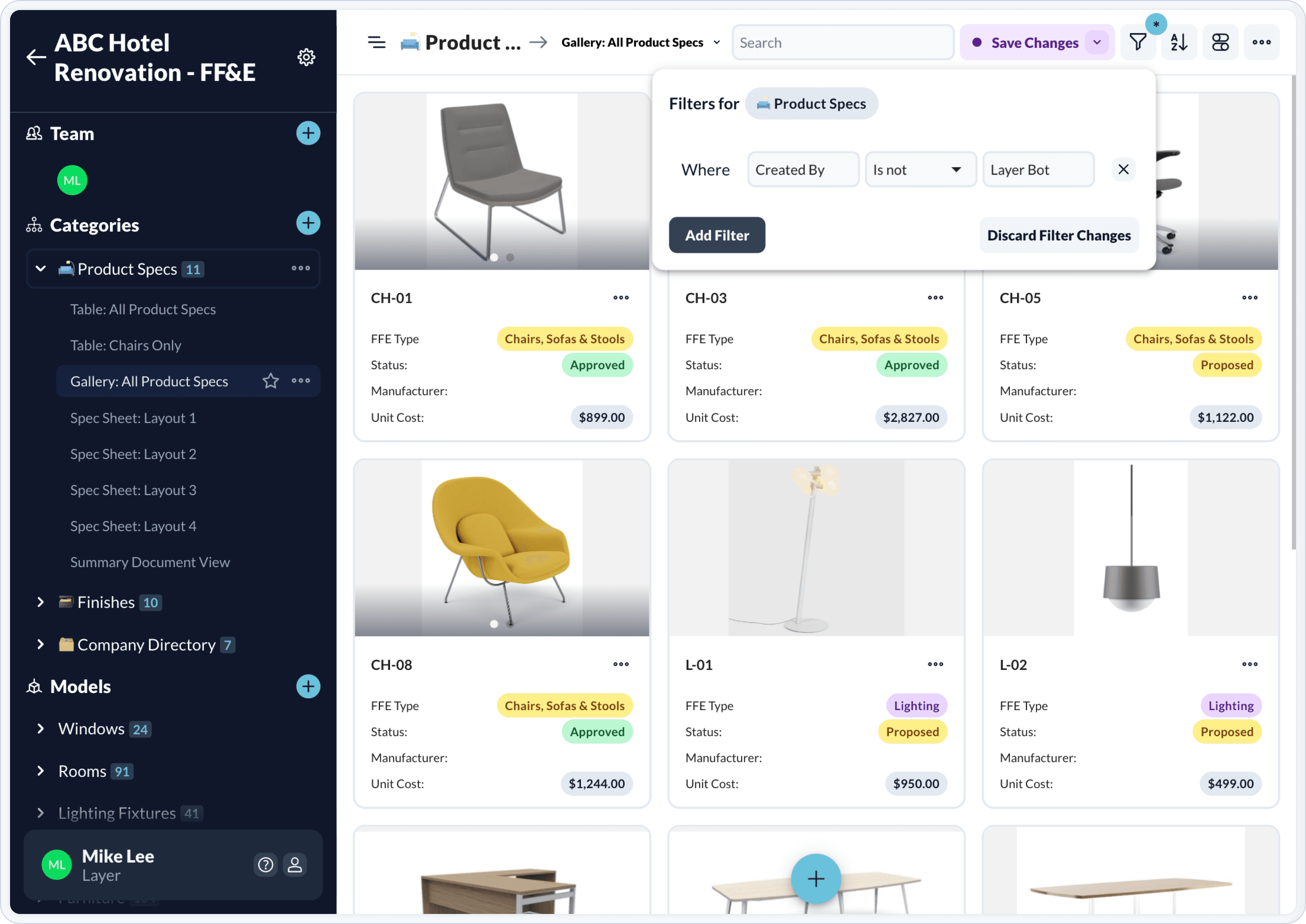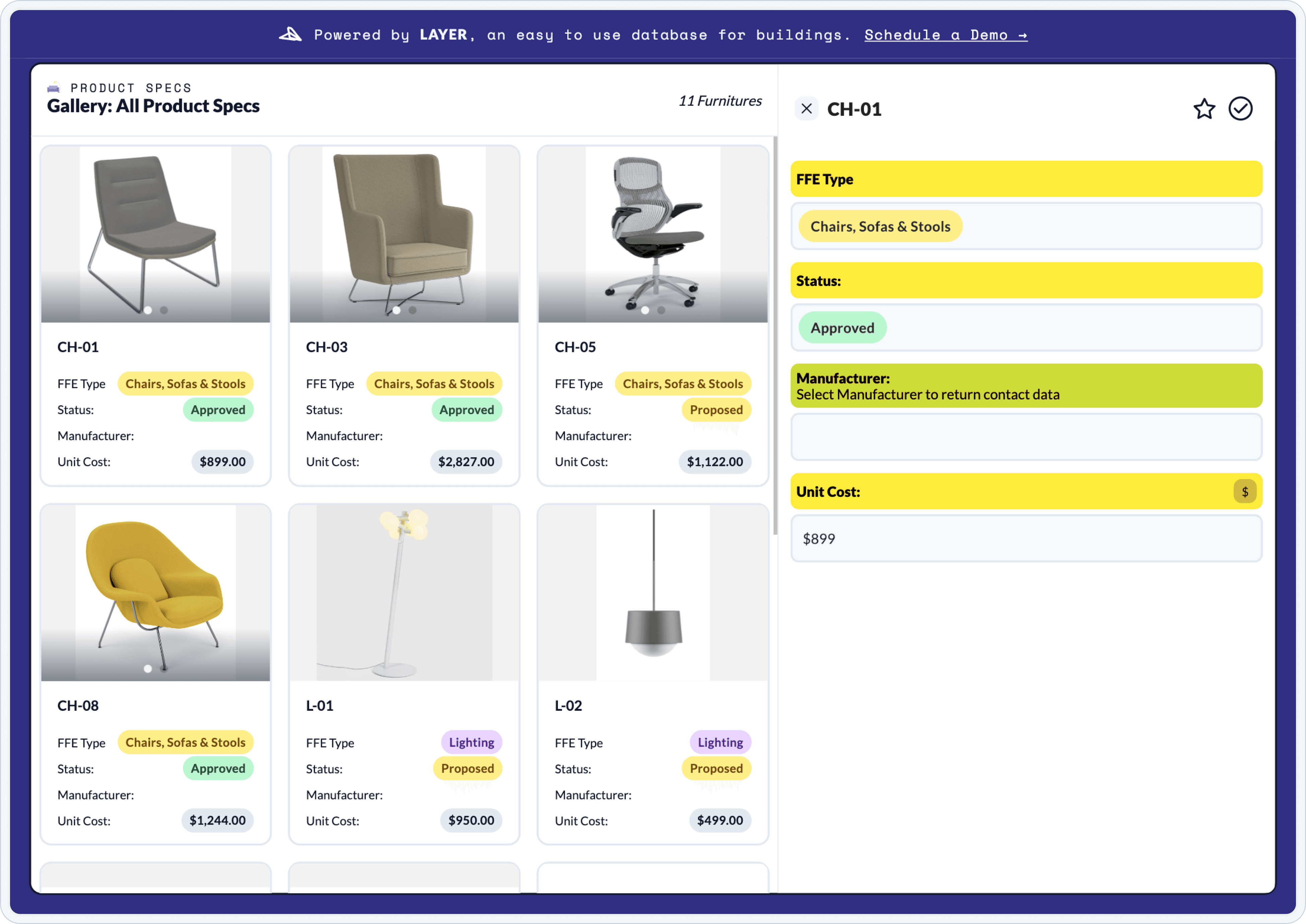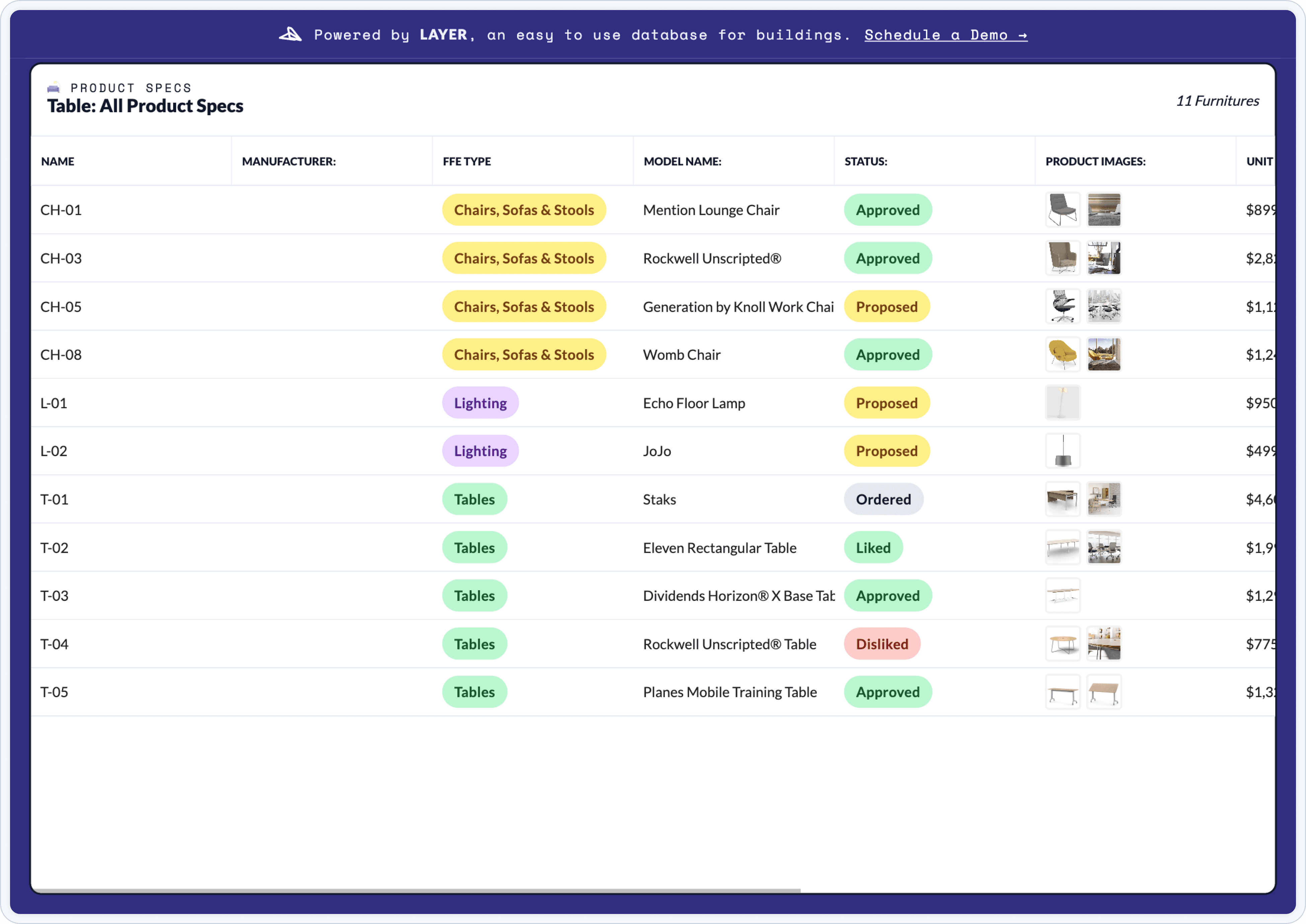Architectural Design
Architectural Design
Architectural Design
An Introduction to Furniture Schedules
An Introduction to Furniture Schedules
An Introduction to Furniture Schedules
A furniture schedule is a detailed document listing types, dimensions, materials, and finishes of furniture for a project. At its core, a furniture schedule is a detailed list that encompasses all pieces of furniture required in a project.

Mike Lee

Mike Lee

Mike Lee
Originally Published: Apr 2, 2024



Contents
Updated:Jan 7, 2026
Each line item in the spreadsheet or software tool you use specifies types, dimensions, materials, and finishes. This precision aids procurement professionals in purchasing the correct pieces and gives detail to the installation team on site.
Why are Furniture Schedules so important?
Furniture schedules streamline communication between teams working on the same project. They are a single source of truth for designers, contractors, and clients to collaborate together from. This record prevents costly misunderstandings such as purchasing the wrong furniture or errors during construction such as installing pieces in the incorrect location.
Furniture schedules may also serve as a source of truth for sustainability and compliance teams when reviewing the project's bill of materials. Easy-to-access documentation of the eco-friendly materials you purchased will make their reporting efforts easier.
When is a Furniture Schedule Created?
Creating a furniture schedule starts early in the design phase. Architects and designers collaborate with their clients to select furniture that complements the space while maintaining the project's vision. They consider aesthetics, function, and durability in their choices. This early planning ensures that furniture enhances the overall design vision.
Each item in the schedule is tagged with a unique identifier. These tags appear on floor plans, showing the location of each piece.

Layer Pro-Tip: Consider using a barcode as each piece of equipment's unique identifier on large projects. Layer makes it simple with mobile-ready scannable barcode fields! See Layer FF&E Template →
Specifications within the Schedule
Specifications within the schedule cover a wide range of details. This detail includes manufacturer's information, model numbers, and potentially custom requirements. For custom or bespoke pieces, drawings and additional specifications may accompany the schedule. These details guarantee that the final product meets the project's needs.
Additional Specifications
For custom or bespoke pieces, drawings, models, or additional specifications may be required. It's important to manage both these details and the deadlines the manufacturer will need to meet the project's proposed schedule.
Budgeting and Procurement
Cost estimators and/or procurement rely on furniture schedules to budget accurately. They use this detailed information to forecast the total cost of furniture procurement. This step is vital for keeping the project within financial bounds. It also allows for adjustments in an easy-to-visualize manner before final decisions and purchases are made.

Updating the Furniture Schedule
Keeping the furniture schedule up to date is an ongoing process. Changes in design, client preferences, or budget can lead to revisions. Regular updates ensure that the schedule remains accurate throughout the project lifecycle. Furniture schedules are a dynamic document that adapt to evolving project requirements.
Construction and Interior Fitout
During construction and interior fitout, the schedule becomes a checklist. Contractors and installers reference it to verify that the correct items are placed as planned. This step is crucial for achieving the intended design outcome. It ensures that the finished space matches the designer's vision and client's expectations.
Future Maintenance and Replacements
Finally, furniture schedules facilitate future maintenance and replacements. Once the project is handed over to the client, a furniture schedule may be used as the starting point for a building's inventory. This information is useful for tracking warranties, ordering replacements, or matching new pieces to existing ones. It serves the owner or building manager as a long-term resource.

Conclusion
In conclusion, furniture schedules are more than just lists. Furniture schedules are important because they provide a detailed inventory of all furniture items, including their specifications, quantities, and placement within a project. This ensures accurate procurement, streamlines installation, and helps maintain consistency with the design intent. By consolidating this information, furniture schedules facilitate clear communication among stakeholders and reduce the likelihood of delivering your project over schedule or budget.
Each line item in the spreadsheet or software tool you use specifies types, dimensions, materials, and finishes. This precision aids procurement professionals in purchasing the correct pieces and gives detail to the installation team on site.
Why are Furniture Schedules so important?
Furniture schedules streamline communication between teams working on the same project. They are a single source of truth for designers, contractors, and clients to collaborate together from. This record prevents costly misunderstandings such as purchasing the wrong furniture or errors during construction such as installing pieces in the incorrect location.
Furniture schedules may also serve as a source of truth for sustainability and compliance teams when reviewing the project's bill of materials. Easy-to-access documentation of the eco-friendly materials you purchased will make their reporting efforts easier.
When is a Furniture Schedule Created?
Creating a furniture schedule starts early in the design phase. Architects and designers collaborate with their clients to select furniture that complements the space while maintaining the project's vision. They consider aesthetics, function, and durability in their choices. This early planning ensures that furniture enhances the overall design vision.
Each item in the schedule is tagged with a unique identifier. These tags appear on floor plans, showing the location of each piece.

Layer Pro-Tip: Consider using a barcode as each piece of equipment's unique identifier on large projects. Layer makes it simple with mobile-ready scannable barcode fields! See Layer FF&E Template →
Specifications within the Schedule
Specifications within the schedule cover a wide range of details. This detail includes manufacturer's information, model numbers, and potentially custom requirements. For custom or bespoke pieces, drawings and additional specifications may accompany the schedule. These details guarantee that the final product meets the project's needs.
Additional Specifications
For custom or bespoke pieces, drawings, models, or additional specifications may be required. It's important to manage both these details and the deadlines the manufacturer will need to meet the project's proposed schedule.
Budgeting and Procurement
Cost estimators and/or procurement rely on furniture schedules to budget accurately. They use this detailed information to forecast the total cost of furniture procurement. This step is vital for keeping the project within financial bounds. It also allows for adjustments in an easy-to-visualize manner before final decisions and purchases are made.

Updating the Furniture Schedule
Keeping the furniture schedule up to date is an ongoing process. Changes in design, client preferences, or budget can lead to revisions. Regular updates ensure that the schedule remains accurate throughout the project lifecycle. Furniture schedules are a dynamic document that adapt to evolving project requirements.
Construction and Interior Fitout
During construction and interior fitout, the schedule becomes a checklist. Contractors and installers reference it to verify that the correct items are placed as planned. This step is crucial for achieving the intended design outcome. It ensures that the finished space matches the designer's vision and client's expectations.
Future Maintenance and Replacements
Finally, furniture schedules facilitate future maintenance and replacements. Once the project is handed over to the client, a furniture schedule may be used as the starting point for a building's inventory. This information is useful for tracking warranties, ordering replacements, or matching new pieces to existing ones. It serves the owner or building manager as a long-term resource.

Conclusion
In conclusion, furniture schedules are more than just lists. Furniture schedules are important because they provide a detailed inventory of all furniture items, including their specifications, quantities, and placement within a project. This ensures accurate procurement, streamlines installation, and helps maintain consistency with the design intent. By consolidating this information, furniture schedules facilitate clear communication among stakeholders and reduce the likelihood of delivering your project over schedule or budget.
Keep Reading
Keep Reading
Related Layer Templates
Related Layer Templates
Get Started Today
Want to see how Layer can transform the way your team works?
Get Started Today
Want to see how Layer can transform the way your team works?
Get Started Today
Want to see how Layer can transform the way your team works?
Solutions
Solutions
Solutions



